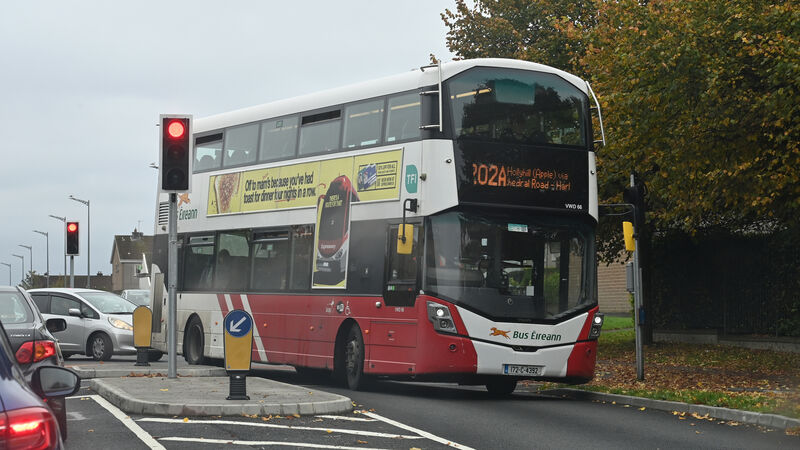Irish Examiner view: Waiting for progress on public transport

We learned from Tadgh McNally and Sean Murray the sheer scale of bus-users’ unhappiness. They reported that almost 6,000 complaints have been submitted to the NTA about delayed, cancelled, or the notorious “ghost” buses in the first five months of this year alone. Picture: Dan Linehan
The travails of public transport, and the challenges facing its adherents, were plain to see in two stories covered here this week.
First, the news reported by Sean Murray about the MetroLink, the long-awaited rail project which is to link Dublin City centre with Dublin Airport. It has finally been given the thumbs-up by An Coimisiún Pleanála, which published the railway order yesterday morning.
That gives the green light for construction of the project —an 18.8km railway line — much of which will be underground. However, much of the coverage has also noted that the planning process which led to yesterday’s permission took three years, in which time costs have increased, traffic congestion has worsened in the capital, and more and more vehicle emissions have damaged the environment.
On the same day, we learned from Tadgh McNally and Sean Murray the sheer scale of bus-users’ unhappiness. They reported that almost 6,000 complaints have been submitted to the National Transport Authority (NTA) about delayed, cancelled, or the notorious “ghost” buses in the first five months of this year alone (“ghost” buses are those which appear as active on the live timetable, before vanishing without trace).
To be precise, the NTA says 5,984 complaints about bus services were made up to May 19. This suggests that we may easily have more than 10,000 complaints by the end of this year.
The essential requirement of public transport is reliability, surely. If people are to be encouraged to forsake private cars for buses then they must be confident that those buses will actually arrive, which appears to be a statement of the obvious until one considers the 6,000 bus-related complaints made already this year.
The MetroLink news is encouraging, but the length of time this matter took to get through the planning process is an embarrassment.
It has been pointed out that it took approximately the same amount of time to connect Dublin and Cork by rail in the 19th century, which should make us all pause this morning as we await the next step in the MetroLink saga.
Gardaí seek to identify woman
Readers should pay close attention to an unusual request made by An Garda Síochána this week. They are appealing for information to help identify a woman whose remains were discovered at a construction site on the Midleton to Youghal Greenway in Cork on January 5, 2021.
As reported here by Manon Gilbart, forensic examinations suggest the skeletal remains are those of a woman aged 70 or older at the time of death, which is believed to have occurred between 1985 and 1987.
The gardaí have released information about the woman — she was 5’ to 5’ 2” with a large frame; she was also arthritic, had 1960s dentures, and took a size 2 shoe. They have also released a facial reconstruction illustration.
It is worth considering the tone of the Garda appeal for information — that they “are determined to identify this person and treat them with the respect and dignity they deserve”.
That should certainly strike a chord with readers: All of us are cognisant of the need to mark the passing of loved ones appropriately, and here we have the case of a person whose remains appear to have been left neglected and forgotten for almost four decades.
That is a particularly puzzling aspect of this case; Irish society in the mid-80s, long before social media isolated so many of us from each other, was certainly less fragmented, and it seems difficult to believe that a person might vanish and be unaccounted for. However, this appears to be the case here, with the gardaí stating that DNA testing has drawn a blank in identifying the woman, while there are also no likely matches in their records of missing people.
Readers are encouraged to consult the details carried in this newspaper and to come forward if they have any information which might help. No matter how insignificant it might appear to be, the Garda investigation team will welcome that information and determine its importance.
One of a kind
The death of Jane Goodall, at the age of 91, was announced this week.
Goodall became world famous as a primatologist, making breakthrough discoveries in the early 1960s in her particular subject of expertise — chimpanzees. She observed chimps eating meat and also using tools to catch insects, challenging decades of presumptions about primate behaviour.
That focus on chimpanzees soon led her to start the Jane Goodall Institute, which aimed to improve understanding of primates and to help protect their natural habitats with the assistance of local people.
The institute now has a presence in more than 25 countries around the world.
She also campaigned against the use of animals in medical research, while her Roots and Shoots project, founded to involve young people in conservation, has a network of people working across nearly 100 countries.
Goodall also had a sense of humour. When the famous cartoonist Gary Larson referred to her in one of his Far Side cartoons, officials at her institute complained, but Goodall was delighted and later wrote the foreword for one of Larson’s books.
It is a commentary on our times, perhaps, that last June there were reports that one of the Jane Goodall Institute projects protecting chimpanzees in Tanzania was facing closure because of US president Donald Trump’s decision to cut the budget of the US Agency for International Development.
CONNECT WITH US TODAY
Be the first to know the latest news and updates












